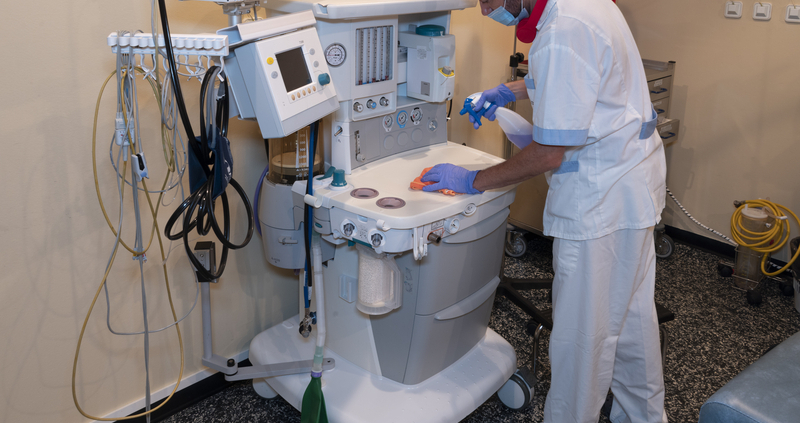Environmental Decontamination: Stages & When to Implement
In a healthcare setting, “environmental decontamination” refers to the process of thoroughly cleaning surfaces as part of effective infection prevention and control.
In this post we’ll discuss the various stages of environmental decontamination in hospitals and healthcare settings and explain when these should be implemented.
The Role of Environmental Decontamination in Infection Prevention and Control
Staff and patients carrying communicable diseases can shed pathogens in a number of ways. These pathogens can survive on surfaces for hours, days, and even months.
In this way, contaminated surfaces can contribute to the person-to-person transmission of pathogens in healthcare settings. This presents a serious risk for certain high-risk patients, including the elderly, the immunocompromised, and the immunosuppressed.
Patients from high-risk groups may be more likely to contract infections from contaminated surfaces. And if they do pick up an infection, they’ll be more likely to experience severe symptoms.
While manual cleaning can contribute to infection prevention and control, if the cleaning agent itself becomes contaminated with pathogens, then the cleaning process could actually contribute to the spread of infection. Environmental decontamination goes beyond surface level cleaning. It’s a strategy for removing and destroying infectious pathogens and contaminants.
The Three Stages of Environmental Decontamination
- Cleaning
- Enhanced cleaning
- Disinfection
Stage 1: Cleaning
The cleaning stage of the environmental decontamination process involves physically removing dirt, dust, and other contaminants from surfaces.
In most healthcare settings, cleaning should take place at least once a day.
Using a combination of mops, brushes, cloths and detergents, cleaning will remove the sort of organic matter from surfaces on which pathogens can take hold. However, it is unlikely to eliminate potentially harmful microorganisms entirely.
As such, cleaning might suffice for items and surfaces that will not come in direct contact with the patient.
Stage 2: Enhanced Cleaning
Some infection prevention and control procedures will call for enhanced cleaning processes. This might simply extend to an increased frequency of fundamental cleaning processes. Or it may call for the use of more specialised disinfectants or equipment.
In some areas of the hospital, such as an operating theatre, enhanced cleaning procedures may take place as a matter of course as part of a wider infection control protocol. Otherwise, enhanced cleaning might be recommended as a response to an outbreak of a communicable disease (such as norovirus); or as part of a containment response to a spillage (of bodily fluids, or chemicals etc.)
Stage 3: Disinfection
Enhanced cleaning may remove microbes and pathogens, but it will not necessarily kill them. Manual disinfection can actively reduce the levels of infectious agents in the area.
As with enhanced cleaning, disinfection may extend to simply making use of specific disinfectant agents as advised. And as with enhanced cleaning, disinfection might be standard practice in some healthcare settings, or it might be recommended as part of the response to a specific event.
For example, any surface contaminated with bodily fluids, such as blood or diarrhea, will require disinfection. Cleaning and enhanced cleaning processes will first serve to make the area visibly clean. Meanwhile, manual disinfection will serve to remove as many lingering microbes as possible.
Different Decontamination Procedures for Medical Equipment
As the name suggests, environmental decontamination is all about removing pathogens from the healthcare environment. This might involve floors, surfaces, windows, items of furniture, and so on.
When it comes to medical equipment – particularly items that might come into contact with a patient’s mucous membrane – healthcare workers must consider three separate levels of decontamination: cleaning, sterilization, and disinfection.
All medical equipment and devices will have different risk levels depending on how frequently they’re used, and where they’re used. This risk level will determine the level of decontamination required, and how often the decontamination procedure should take place.
Read our full guide to the three levels of decontamination for medical devices.
Essential Support for Effective Environmental Decontamination
We stock a full range of highly effective hospital cleaning and disinfectant products, including the powerful Virusolve+ range of wipes and concentrates. Browse our complete range of infection control products.
With our hospital-grade air purifiers we can also help you reduce the levels of airborne pathogens in your hospital, along with other potentially hazardous pollutants, such as VOCs, inhalable dust, and particulate matter. Browse our range of air purification solutions for healthcare settings.



